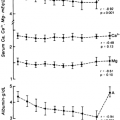TREATMENT OF ENDOMETRIOSIS: ANDROGEN THERAPY
Part of “CHAPTER 98 – ENDOMETRIOSIS“
The first hormonal treatment of endometriosis was the intramuscular administration of testosterone. High-dose parenteral testosterone therapy was demonstrated to cause regression in endometriosis lesions. Unfortunately, many women became virilized. Androgen treatment was resurrected after the development of synthetic oral androgens, such as danazol, which have attenuated androgen properties.31
Danazol is a derivative of ethinyl testosterone and has moderate affinity for the androgen receptor, with a dissociation constant of ˜10-9 mol/L32; it also has weak affinity for the progesterone receptor, but no physiologically significant binding to estrogen or glucocorticoid receptors. At high doses, danazol directly suppresses cellular activity in endometriosis lesions, probably by acting through androgen and/or progestin receptors. In addition, the drug can modestly suppress pituitary secretion of LH and FSH, which in turn suppresses ovarian follicular growth, blocks ovulation (at doses >200 mg per day), and decreases the estradiol concentration to early follicular phase levels (30 pg/mL). The combination of an increase in androgen action and a decrease in estrogen action causes atrophy of the endometriosis lesions.
Stay updated, free articles. Join our Telegram channel

Full access? Get Clinical Tree





